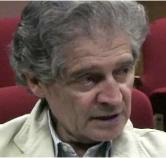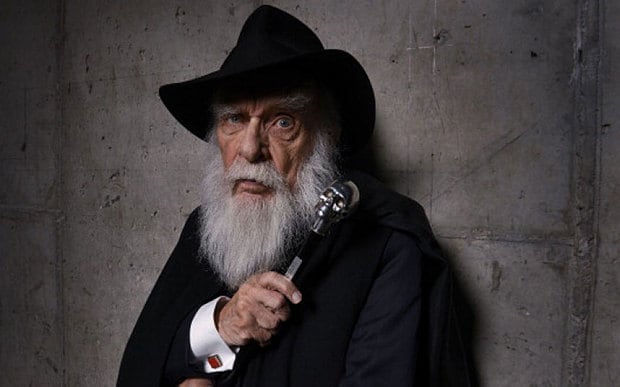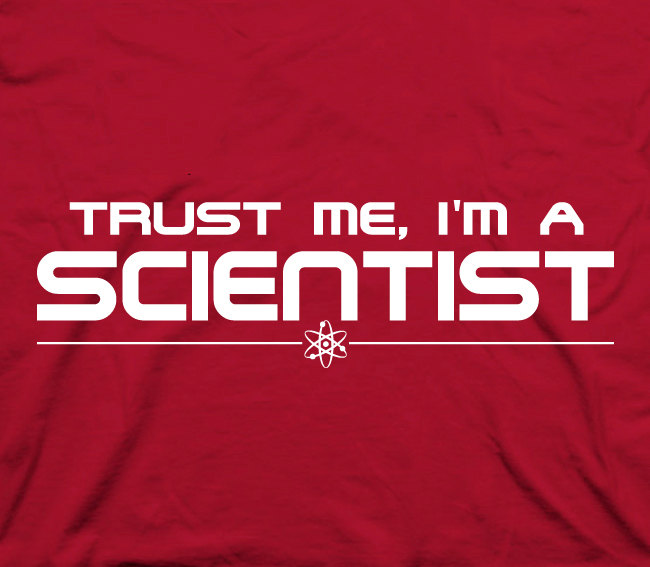Jacques Benveniste and Water Memory

We are not realists. We are not idealists. We are intermediatists that nothing is real, but that nothing is unreal: that all phenomena are approximations one way or the other between realness and unrealness.
So…that our whole quasi-existence is an intermediate stage between positiveness and negativeness or realness and unrealness.
Like purgatory, I think.
Charles Fort ‘Wild Talents’
But what those, who like to think they run the science show, or those like the late “skeptic” James Randi who are sure they have a monopoly on what is true and wholesome, would like us to think, is that words uttered by science bear a close relationship to absolute truth. Science however, is supposed to be a permanent work-in-progress without absolutes or certainties, only theories that may be dis-proven.

The sad tale of Jacques Benveniste is a story that involves the mythical certainty of science. That according to the scientific discipline of physics, what Benveniste claimed to have discovered, is impossible.
At that time Benveniste was head of allergy and inflammation immunology at the French government biomedical research agency INSERM (Institut de la Santé et de la Recherche Médicale). In 1984 (or it may have been 1988, the time-line is confused) Benveniste was studying how allergies affected the body. He focused on a type of blood cell known as a basophil, which activates when it comes into contact with a substance you’re allergic to.
The saga began when a member of his staff put a homeopathically (very dilute) alergy remedy through a test devised by Benveniste. (It emerged that Benveniste had never performed the experiment himself.) To the surprise of the staff member or maybe the delight?, as the person in question is said to have been interested in Homeopathy, the test showed that even when the allergic substance was diluted down to homeopathic quantities, it could still trigger a reaction in the basophils.
Benviniste submitted his paper to Nature.
As a condition for publication, Nature asked for the results to be replicated by independent laboratories. The controversial paper published in Nature was eventually co-authored by four laboratories worldwide, in Canada, Italy, Israel, and France.
Questions:
1) Who were these laboratories, no one seems to know?
2) Why was the paper accepted by Nature in the fist place as Homeopathy was and is still a taboo subject in science?
3) Wiki tells us: ” The papers that have been published in this journal are internationally acclaimed for maintaining high research standards. Less than 8% of submitted papers are accepted for publication.” so why this one?

The article was withheld for two years and this may account for some of the time-line discrepancies. What is certain, with two years to think about publication, the editor Maddox was in no doubt about its contents or about the repercussions that would surely follow publication. It appears that Sir John Maddox, editor of Nature journal was preparing to cry havoc and let-slip the academic dogs of war.
After the article was published, a follow-up investigation was set up by a team including physicist and Nature editor John Maddox, illusionist and well-known skeptical debunker James Randi, as well as fraud expert Walter Stewart who had recently raised suspicion on the work of Nobel Laureate David Baltimore. https://en.wikipedia.org/wiki/Jacques_Benveniste
Two years later, (1990) then aged 55, Benveniste was sacked from his job at France’s government-sponsored medical research body, the Institut National de la Santé et de la Recherche Médicale (Inserm).
https://www.theguardian.com/science/2004/oct/21/obituaries.guardianobituaries
The Caveat Trap
“Nature’s Editorial reservation: Readers of this article may share the incredulity of the many referees. . . There is no physical basis for such an activity. . . Nature has therefore arranged for independent investigators to observe repetitions of the experiments.”
http://www.scienceandreason.ca/pseudoscience/alternativemedicine/water-memory-tests-all-wet/
https://www.theguardian.com/science/2004/oct/21/obituaries.guardianobituaries
The Debunking Team – caveat emptor
Sir John Maddox, editor of Nature was a physicist and although they all seem to have insisted on double blind tests, I know of no instance where a physicist has used double blind in any physics experiment.
See his “Book for Burning” attack in Nature aimed at “A New Science of Life”, by Rupert Sheldrake. Quote by Maddox:…holists of his ilk would not dream of letting controls get in the way of revealed truth.


James Randi, a professional magician, professional ‘skeptic’, debunker and self publicist: probably suggested the double blind test as it gave him an excuse to tape the results to the ceiling. This is a common ploy among performing magicians and as we will see someone does seem to have tampered with them.
My own page on other professional sceptics can be found here

Walter Stewart, an expert on science fraud and the scientific equivalent of the Witchfinder General. There is very little information to be found on Stewart, he is some kind of medic and the only one of the team likely to know anything about immunology.
It seems the only thing the trio have in common is their love of the debunking game. Debunking is much easier than doing good science. See Obsessive Debunking Disorder

theguardian.com: The three spent a week in Benveniste’s Paris laboratory. The first day was spent talking; the second, planning; the third preparing blood cells and reagents for the test; and the fourth was devoted to the experiments. At the end of that session, the raw data was wrapped in tinfoil and taped to the ceiling, so that any attempt to tamper with it overnight would be noticed. The next morning, the tinfoil had been disturbed but not opened, as if an attempt to open it had been abandoned. The data was interpreted by Elisabeth Davenas, who had done the original research, and the results were significant; but when the labels were removed and she analysed the results “blind”, they were shown to be random. https://www.theguardian.com/science/2004/oct/21/obituaries.guardianobituaries
Questions:
1) Who tampered with the data?
2) What possible motive could there be for doing so after four positive results?
On the Role of Stage Magicians in Biological Research
A Commentary by Jacques Benveniste and Peter Jurgens
Reprinted from The Anomalist 6
Copyright 1998 by The Anomalist
Read the whole thing here
Benveniste: ” In short, they concluded the absence of an effect because, after four successful experiments, a fifth didn’t “work.”
Extract: “And the third member of the fraud squad? A stage magician! However, our stage magician wasn’t your run-of-the-mill prestidigitator: he had, in the tradition established by Houdini, long since decided to become a defender of “rationality” against the irrational fringe and creepy-crawlies in general. Us.
“I will not dwell on the unfavorable conclusions of the scientific members of the committee. It’s not that I wish to avoid the subject, but rather that I wish to stay on the subject: the role of stage magicians in biological research. In short, they concluded the absence of an effect because, after four successful experiments, a fifth didn’t “work.” In rebuttal, I simply refer the reader to the article confirming our initial findings, which appeared in the Comptes Rendus de l’Acadïmie des Sciences de Paris in 1991, wherein we report the results of subsequent blind experiments entirely designed and run by Professor Alfred Spira, and his research unit of independent statistical experts.
Now back to the magician. He really did us proud. He had, indeed, in his cap, several feathers worth boasting about in the course of his (presumably lucrative) lectures. One was Uri Geller. The object of a campaign of ridicule disguised as rationality, Geller’s ability was denied. The conjurer could also bend metal using the tricks of his trade. Another feather was the University of Washington affair in which stooges planted by our conjurer in the guise of experimental subjects faked results and led a whole research department on a wild goose chase for over a year before he — to the delight of those willing to sacrifice intellectual honesty for delight — triumphantly proclaimed his trickery.
Passing over other coups, let us return to our laboratory, where the magician surveyed work with professional attention, noting, no-one knew what, for at the time he accused not a soul nor claimed the discovery of any dark secret. It was with surprise, therefore, that we read in the Nature report on the visit, of his observation (no doubt with an exceedingly professional eye, for no-one else had noticed) that the piece of paper containing the codes taped to the ceiling (the experiments were performed blind) had been tampered with. Furthermore, his skills permitted him to have observed that a small, ultra-light stepladder leaning against a nearby wall had changed position overnight. One is left somewhat perplexed as to the motivation for this supposed skullduggery, for it preceded the single unsuccessful experiment. What matters is that this “exposï” transformed a prestigious laboratory of more than 50 research workers into a feather in a magician’s cap.” http://www.anomalist.com/commentaries/magician.html
Professor Madeleine Ennis
 theguardian.com: Professor Madeleine Ennis of Queen’s University Belfast
theguardian.com: Professor Madeleine Ennis of Queen’s University Belfast
This last notion, famously promoted by French biologist Dr Jacques Benveniste, cost him his laboratories, his funding, and ultimately his international scientific credibility. However, it did not deter Professor Ennis who, being a scientist, was not afraid to try to prove Benveniste wrong. So, more than a decade after Benveniste’s excommunication from the scientific mainstream, she jumped at the chance to join a large pan-European research team, hoping finally to lay the Benveniste “heresy” to rest. But she was in for a shock: for the team’s latest results controversially now suggest that Benveniste might have been right all along…
A British attempt (by scientists at London’s University College, published in Nature in 1993) to reproduce Benveniste’s findings failed. Benveniste has been striving ever since to get other independent laboratories to repeat his work, claiming that negative findings like those of the British team were the result of misunderstandings of his experimental protocols. Enter Professor Ennis and the pan-European research effort.
A consortium of four independent research laboratories in France, Italy, Belgium, and Holland, led by Professor M Roberfroid at Belgium’s Catholic University of Louvain in Brussels, used a refinement of Benveniste’s original experiment that examined another aspect of basophil activation. The team knew that activation of basophil degranulation by aIgE leads to powerful mediators being released, including large amounts of histamine, which sets up a negative feedback cycle that curbs its own release. So the experiment the pan-European team planned involved comparing inhibition of basophil aIgE-induced degranulation with “ghost” (Homeopathic) dilutions of histamine against control solutions of pure water.
In order to make sure no bias was introduced into the experiment by the scientists from the four laboratories involved, they were all “blinded” to the contents of their test solutions. In other words, they did not know whether the solutions they were adding to the basophil-aIgE reaction contained ghost amounts of histamine or just pure water. But that’s not all. The ghost histamine solutions and the controls were prepared in three different laboratories that had nothing further to do with the trial.
The whole experiment was coordinated by an independent researcher who coded all the solutions and collated the data, but was not involved in any of the testing or analysis of the data from the experiment. Not much room, therefore, for fraud or wishful thinking. So the results when they came were a complete surprise.
Three of the four labs involved in the trial reported a statistically significant inhibition of the basophil degranulation reaction by the ghost histamine solutions compared with the controls. The fourth lab gave a result that was almost significant, so the total result over all four labs was positive for the ghost histamine solutions.
(Note: this is significant as the Maddox, Randi and Stewart tests were declared a failure “after four successful experiments, a fifth didn’t work.”)
Still, Professor Ennis was not satisfied. “In this particular trial, we stained the basophils with a dye and then hand-counted those left coloured after the histamine- inhibition reaction. You could argue that human error might enter at this stage.” So she used a previously developed counting protocol that could be entirely automated. This involved tagging activated basophils with a monoclonal antibody that could be observed via fluorescence and measured by machine.
The result, shortly to be published in Inflammation Research, was the same: histamine solutions, both at pharmacological concentrations and diluted out of existence, lead to statistically significant inhibition of basophile activation by aIgE, confirming previous work in this area.
“Despite my reservations against the science of homoeopathy,” says Ennis, “the results compel me to suspend my disbelief and to start searching for a rational explanation for our findings.” She is at pains to point out that the pan-European team have not reproduced Benveniste’s findings nor attempted to do so.
Jacques Benveniste is unimpressed. “They’ve arrived at precisely where we started 12 years ago!” he says. Benveniste believes he already knows what constitutes the water-memory effect and claims to be able to record and transmit the “signals” of biochemical substances around the world via the Internet. These, he claims, cause changes in biological tissues as if the substance was actually present. https://www.theguardian.com/science/2001/mar/15/technology2
BBC Horizon
The video below, by the BBC, gives an insight into what went-on during the Million Dollar Test but its conclusions are biased and questionable to those with a critical ability.
BBC.Horizon-Homeopathy.The.Test-2002 video
bbc.co.uk/science/horizon
BBC Two, Tuesday 26 November, 9pm
Homeopathy: The Test – transcript:
MADELEINE ENNIS: I have no explanation for what happened. However, this is science. If we knew the answers to the questions we wouldn’t bother doing the experiments.
What’s going on?
– Appeal to Authority – The inability to think for one’s self in the face of a scientific authority.

“Science is not powerful because it’s right, science is right because it’s powerful.”
There are so many unanswered questions in the Benveniste affair that it’s hard to know where to start. The negative results must be outnumbered by the positive by at least three to one and yet the single failure witnessed by the Nature team is taken as the last word by most commentators. It appears that the words – Nature journal and it’s accompanying editor, a physicist, or even the word debunker – were enough to swing opinion without an iota supporting evidence.
Homeopathy has been around for a long, long time and telling farmers that they wasted their money on a homeopathic vet who did a good job is not likely to make the sKeptics popular. But these people often make a living from the gullibility of others. There are those poor, unfortunate souls who think it makes them smart – they think they are being scientific.
Sheep and Goats
There is another solution to the problem of intermittent results that is perfectly scientific:
Gertrude Schmeidler and the Sheep-Goat Effect,
 “In 1942, Gertrude Schmeidler, professor of psychology at City University of New York, set up a questionnaire to explore students’ beliefs about psi. She used the term “sheep” to refer to those who were confident about the reality of psi and “goats” for those who doubted its existence or its pertinence in the context of the test. After the questionnaire, she gave the students a classic psi test with ESP cards in which they tried to guess sequences of target-cards. Then Schmeidler compared the results of the psi test and those of the questionnaire. The remarkable conclusion was that the “sheep” had a significant deviation above chance, while “goats” were significantly below it… This difference between believers and disbelievers, known as the “sheep-goat effect,” has been confirmed by many other researchers.” http://archived.parapsych.org/sheep_goat_effect.htm
“In 1942, Gertrude Schmeidler, professor of psychology at City University of New York, set up a questionnaire to explore students’ beliefs about psi. She used the term “sheep” to refer to those who were confident about the reality of psi and “goats” for those who doubted its existence or its pertinence in the context of the test. After the questionnaire, she gave the students a classic psi test with ESP cards in which they tried to guess sequences of target-cards. Then Schmeidler compared the results of the psi test and those of the questionnaire. The remarkable conclusion was that the “sheep” had a significant deviation above chance, while “goats” were significantly below it… This difference between believers and disbelievers, known as the “sheep-goat effect,” has been confirmed by many other researchers.” http://archived.parapsych.org/sheep_goat_effect.htm
Psi Missing: according to Mario Varvoglis, Ph.D., “Psi missing is one of the most startling discoveries of modern parapsychology. At times, certain individuals persist in giving the wrong answers in psi tests. The accumulation of systematically wrong answers can be so flagrant that it suggests something quite different than a mere lack of psi abilities: it is as if people use psi to consistently avoid the target, unconsciously “sabotaging” their own results!”
So it follows that they may be able to sabotage the results of others! I think Mario Varvoglis is zeroing-in on the weird and tortured mentality of the sceptics who (subconciously?) see self inflicted sabotage as a bona fide means to an end. http://archived.parapsych.org/psiexplorer/belief1.htm
Wikipedia
 Interestingly there is no Wiki page titled ‘Sheep-Goat Effect’ as we have come to expect from sceptics, even though Wiki has promised to give a balanced account of all such subjects. The Wiki sceptics are at a loss to rationalise the effect and so it is excluded. Instead there is a mention under ‘Psi hit’, a title no one is likely to Google because they have never heard of the phrase. There is also no Wiki page for professor Gertrude Schmeidler and her discovery of the Sheep-Goat effect.
Interestingly there is no Wiki page titled ‘Sheep-Goat Effect’ as we have come to expect from sceptics, even though Wiki has promised to give a balanced account of all such subjects. The Wiki sceptics are at a loss to rationalise the effect and so it is excluded. Instead there is a mention under ‘Psi hit’, a title no one is likely to Google because they have never heard of the phrase. There is also no Wiki page for professor Gertrude Schmeidler and her discovery of the Sheep-Goat effect.
Also no mention on Wiki of ‘Psi Missing’ another name for the Sheep-Goat effect.
The Sheep-Goat Effect, it appears, is present in all walks of life, not least in scientific experimentation where the experiment would work for the open minded, but not for the sceptic, a scenario that crops-up throughout the Benveniste saga. Testing for this is completely impossible because the sceptics will claim that it is untestable and therefore unscientific.
Science is bursting at the seams with such paradoxes if the reader cares to look for them.
Further Reading
Hexagonal Water and unconventional science An overview of one of the most amazing discovery of the century. http://hexagonalwater.com/index.html
Human basophil degranulation triggered by very dilute antiserum against IgE
http://www.nature.com/nature/journal/v333/n6176/abs/333816a0.html?foxtrotcallback=true
High Dilution, Homeopathy, and the Purpose of the Scientific Journal
High Dilution, Homeopathy, and the Purpose of the Scientific Journal
Referee opinions and editorial influence: the 1988 INSERM paper
http://rsnr.royalsocietypublishing.org/content/69/3/337#sec-6
Bacteria on the Radio: DNA Could Act as Antenna
https://www.wired.com/2011/04/bacterial-radio/
http://www.nature.com/nature/journal/v435/n7045/full/nature03661.html?foxtrotcallback=true
